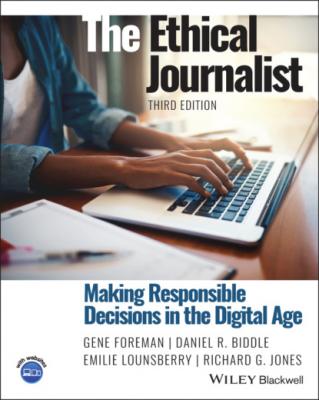The Ethical Journalist. Gene Foreman
Чтение книги онлайн.
Читать онлайн книгу The Ethical Journalist - Gene Foreman страница 9
 Trial by Social Media
Trial by Social Media
6 How the “Trump Effect” Challenged Journalism
The news media had never dealt with a president like No. 45
As a candidate and president (2015 - 2021), Donald Trump vigorously tested journalism’s habits, tools, and tenets.
Modifying their reporting practices, journalists adapted to Trump much as earlier generations had adapted to Senator Joseph R. McCarthy. But the transition was not a smooth one.
To deal with a multitude of false statements, news organizations created fact-checking units and debated whether to use the word lie.
Coverage of Trump and his administration ranged from hard-hitting investigations to snarky commentary that tended to confirm critics allegations of bias.
Point of View: Impartial Journalism’s Enduring Value (Thomas Kent)
7 Applying Four Classic Theories of Ethics
Ancient philosophy can be a factor in the decision-making process
The strengths and weaknesses of four classic ethical theories in the context of editor’s decisions to publish government secrets.
Rule-based thinking - doing the right thing, even if there are consequences.
Ends-based thinking - choosing to do what brings the most good to the most people.
The Golden Rule - treating other people the way you would want to be treated.
Aristotle’s Golden Mean - finding a moderate solution when the extremes won’t work.
The practice of journalism typically blends rule-based thinking and ends- based thinking.
8 Using a Code of Ethics as a Decision Tool
Written professional standards can be a valuable guide
Ethics codes in journalism trace their origins to the early twentieth century, as some editors put word-of-mouth standards into writing.
Codes adopted by professional associations of journalists are voluntary; codes adopted by news outlets for the direction of their staffs are enforceable.
Codes can be useful as a part of the decision process, not as a substitute for that process.
The Society of Professional Journalist’s 2014 revision of its code of ethics is a model for the profession. Its four guiding principles are: seek truth and report it, minimize harm, act independently, and be accountable and transparent.
9 Making Moral Decisions You Can Defend
How to apply critical thinking and a decision template
A careful decision-making process draws on the practical skills of journalism: gathering facts, analyzing them, and making judgments.
Critical thinking - thoughtful analysis - is an essential component of the decision process.
A step-by-step template can guide you to a better decision.
You must test your decision to see if it can be defended.
In this course, approach the case studies as a laboratory exercise in decision-making.
Point of View: Avoid These Rationalizations (Michael Josephson)
Case Study: Deciding Whether to Identify a CIA Agent
Part II: Putting Journalism Ethics to Work
10 Getting the Facts Right and Being Fair
SPJ’s guiding principle of seeking truth and reporting it
Accuracy and fairness are journalism’s fundamental ethical values.
The digital era, with its emphasis on speed, entices reporters to take shortcuts and, thus, to risk mistakes.
Journalists have to be alert for hoaxes, especially on the web.
Problematic trends in the newsroom: less specialization, less editing.
Point of View: Declaring What You Wont Report (Craig Silverman)
Case Study: A Story of Rape at Mr. Jefferson’s University
Case Study: A Double Disaster at the Sago Mine
Case Study: Richard Jewell: He Really Was a Hero
Case Study: The Football Star’s Fictitious Girlfriend
11 Showing Empathy for People in the News
SPJ’s guiding principle of minimizing harm
Recognizing that the truth can hurt, journalists should weigh the information they are reporting against the harm it can be expected to cause. Sometimes that calculation might lead to a decision not to publish a detail of marginal relevance or possibly an entire story or photograph.
Requests from the public to “unpublish” archival content create an ethical dilemma: a desire to protect the historical record versus consideration of the people hurt by that record, especially when it is flawed.
Reporters should take particular care when interviewing children and survivors of a tragedy, or when reporting on suicides.
Journalists should be aware that their presence can be viewed as intrusive.
Case Study: The Death of a Boy
Point of View: Reporting a Fact, Causing Harm (William F. Woo)
12 Avoiding Conflicts: Appearances Count
SPJ’s guiding principle of acting independently
In an actual conflict of interest, journalists allow self‐interest, or a loyalty to any other person or organization, to take precedence over their duty to the audience.
Because a conflict of interest gives the audience reason to doubt the journalist’s loyalty, it undermines credibility.
An appearance of a conflict of interest can damage credibility even if the journalist’s reporting is honest.
By following reasonable guidelines, you can avoid most conflicts, actual or apparent.
Identifying situations that commonly lead to conflicts.
Case Study: A Reporter’s Son Joins a Foreign Army